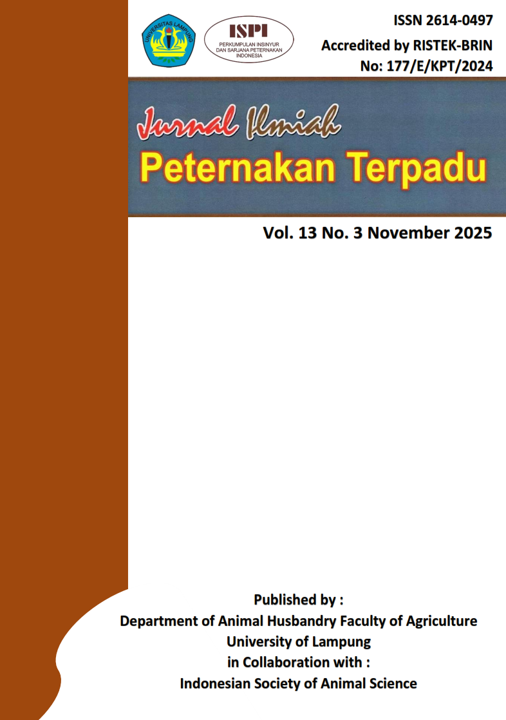The effect of addition red ginger (Zingiber Officinale Var. Rubrum) and garlic (Allium sativum L ) to salted egg quality with the dry curing method
DOI:
https://doi.org/10.23960/jipt.v13i3.p715-726 Abstract View: 62
Abstract View: 62
Keywords:
ducks egg, red ginger, garlic, salted egg.Abstract
This research aims to know the effect addition of red ginger and garlic to salted egg quality with dry curing method. This research used 160 fresh duck eggs which were curing for 14 days with a mixture of red ginger and garlic with 4 treatments that is P0 (without red ginger and garlic (control)), P1 (addition of red ginger 80% and garlic 20%), P2 (addition of red ginger 50% and garlic 50%), P3 (addition of red ginger 20% and garlic 80%) and every treatment there is 4 repetitions, each repetition consisting of 10 duck eggs. The method research was to use organoleptic test on salted eggs on 40 respondents for the judging, The data from the organoleptic test results were calculated using Completely Randomized Design (CRD), if the results of the analysis of variance showed a very real effect, continue using the Duncan Multiple Range Test (DMRT). The research showing that the addition of red ginger and garlic to salted eggs had a very significant effect on the flavour and taste of salted eggs, but not significant effect on the texture and salted eggs sourness. The conclusion of this study is that the best treatment of using red ginger and garlic for salted egg processing is in treatment 2, that is the use of red ginger and garlic as much as 50% seen from the results of the assessment by 40 respondents, then the assessment data were calculated using a completely randomized design. It can be seen from the calculation of data on the RAL that respondents prefer the flavour and taste of salted eggs in treatment 2.
Downloads
References
Fadhlurrohman, I., Sumarmono, J., dan Setyawardani, T. (2021). Tingkat Kemasiran , Kadar Garam Dan Kadar Air Telur Asin Yang. Prosiding, July, 24–25.
Iriani, D., Leksono, T., dan Br Hutahayan, W. R. (2022). Pengaruh Penambahan Jahe Merah (Zingiber officinale var. rubrum) Terhadap Mutu Organoleptik dan Biokimia Ikan Bandeng (Chanos chanos) Presto Selama Penyimpanan Dingin. Jurnal Teknologi Dan Industri Pertanian Indonesia, 14(2), 53–62.
Kristina, Torang, H., dan Wulansari, D. (2023). Pengaruh Berbagai Jenis Bawang Dalam Adonan Telur Asin Itik Terhadap Kualitas Uji Organoleptic. Agrienvi, 17(1), 46–52.
Lukman, H., dan Suryono. (2021). Kualitas Organoleptik Telur Asin Dengan Penambahan Bawang. Prosiding Seminar Teknologi Dan Agribisnis Peternakan, 2006, 24–25.
Nalurita, I., Suwasono, S., Kuswardhani, N., dan Isnain, F. S. (2023).Kualitaas Produk Cascara Celup Dengan Penambahan Jahe Merah (Zingiber officinale var. Rubrum). Pro Food, 9(1), 1–11.
Nina, Faridah, A., dan Holinesti, R. (2014). Pengaruh Penambahan Bawang Putih Terhadap Kualitas Telur Asin. Penambahan Natrium Benzoat Dan Kalium Sorbat (Antiinversi) Dan Kecepatan Pengadukan Sebagai Upaya Penghambatan Reaksi Inversi Pada Nira Tebu, September.
Putri, M. F. (2019). Telur Asin Sehat Rendah Lemak Tinggi Protein Dengan Metode Perendaman Jahe Dan Kayu Secang. JKKP (Jurnal Kesejahteraan Keluarga Dan Pendidikan), 6(02), 93–102.
Qomaruddin, M., dan Afandi, H. (2012). Tingkat Kesukaan Konsumen Terhadap Telur Asin Ayam Ras dan Telur Asin Itik Di Kecamatan Kembangbahu, Kabupaten Lamongan. 53, 32.
Ramdayani, S., Lukman, H., dan Resmi, R. (2023). Pengaruh Konsentrasi Garam Terhadap Sifat Organoleptik Telur Asin Oven Yang Dibuat Dengan Cara Basah. Jurnal Ilmiah Ilmu-Ilmu Peternakan, 25(1), 69–82.
Santika, Y. ., Anggrayni, Y. L. ., dan Mahrani. (2022). Penambahan Jahe Gajah (Zingiber officinale Rosc) dan Bawang Putih (Allium sativum L.) Terhadap Kualitas Organoleptik Telur Asin dengan Metode Penggaraman Basah. Jurnal Peternakan (Journal of Animal Science), 6(1), 10–19.
Wediasari, S., Anggrayni, Y. L., dan Mahrani. (2022). Penambahan Jahe Gajah (Zingiber officinale. Rosc) Dan bawang Putih (Allium sativum L) Terhadap Kualitas Organoleptik telur Asin Metode Penggeraman Kering. Jurnal Green Swarnadwipa, 11.
Downloads
Published
How to Cite
Issue
Section
License
Copyright (c) 2025 Puji Astuti, Ridho Wahyu Ramadhan, Bagus andika Fitroh, Putri Awaliya Dughita

This work is licensed under a Creative Commons Attribution 4.0 International License.

Jurnal Ilmiah Peternakan Terpadu(JIPT) is licensed under a Creative Commons Attribution 4.0 International License.
Authors who publish with this journal agree to the following terms:
- Authors retain copyright and grant the journal right of first publication with the work simultaneously licensed under a Creative Commons Attribution License that allows others to share the work with an acknowledgement of the work's authorship and initial publication in this journal.
- Authors are able to enter into separate, additional contractual arrangements for the non-exclusive distribution of the journal's published version of the work (e.g., post it to an institutional repository or publish it in a book), with an acknowledgement of its initial publication in this journal.
- Authors are permitted and encouraged to post their work online (e.g., in institutional repositories or on their website) prior to and during the submission process, as it can lead to productive exchanges, as well as earlier and greater citation of published work (See The Effect of Open Access).





















